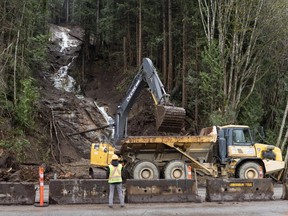Concerns about landslide risks were reignited last week after a mudslide swept through a home in Lions Bay along the Sea to Sky Highway, killing two people.

More than 15 years after a coroner’s investigation recommended that B.C. establish landslide risk tolerance levels for existing homes and future developments, the province has not done so.
Recommended Videos
The recommendation, one of eight to the province from the coroner’s report, was made after an examination of the death of 43-year-old Eliza Wing Mun Kuttner in a landslide on Jan. 19, 2005 that carried a District of North Vancouver home down a steep slope at 3:30 a.m.
Creating landslide risk tolerance levels, also called landslide safety levels, would help communities and experts determine whether, for example, it is safe to build along steep slope areas or where there are creeks, and whether changes are needed to protect existing homes.
The B.C. government did not respond to Postmedia questions put to them last week about why the province had not adopted the landslide safety levels or how it had responded to the eight coroner’s recommendations.
Scott McDougall, a University of B.C. associate professor of engineering, says the hesitation to institute provincewide or Canada-wide landslide safety thresholds may be because if you do so, then you have to suddenly deal with homes that are above that threshold.
“That can be, politically, a difficult exercise and obviously really costly if you want to try to deal with it quickly,” he observed.
In the absence of provincewide levels, communities are left to deal with the landslide safety levels on their own.
Following a landslide that killed two people in Lions Bay in 1983, work was done on creeks above the community to reduce landslide risk. Village officials have said that work — which included building debris catchment basins — was likely carried out and paid for by the province to protect the highway as it would have “bankrupted” the community.
The province has been unable to say exactly what landslide risk reduction work has been carried out along the Sea to Sky Highway corridor and how much it cost.
The work after 1983 did not include the area of Battani Creek where the recent Lions Bay slide originated.
Avi Kuttner, the daughter of the woman who died in the District of North Vancouver landslide, said she believes the province should be doing more, providing increased funding and guidance to local communities, particularly given that climate change is exacerbating natural hazards such as landslides.
“Landslides are also often seen as random which leads people to be even less likely to do preparatory work,” she said.
The coroner’s report into her mother’s death warned 16 years ago that population growth pressure would likely result in more residential developments encroaching onto steeper slopes in many parts of the province.
“Whenever development occurs on sufficiently steep ground, as was the case with the Berkley-Riverside Escarpment, some degree of risk to human life and property will always be present. Even though such risk cannot be fully eliminated, it is possible to assess the level of risk and apply appropriate control measures, if that level of risk is deemed unacceptable,” Pawlowski wrote in his report.
He also recommended the province develop a comprehensive landslide hazard management strategy focused on prevention and mitigation risk, consider establishing a legislated standard for how landslide assessments should be conducted and co-ordinate the development of provincial guidelines to assist local governments in recognizing when a risk assessment should be carried out.
The recommendations also called for the province to develop and administer standardized training and education for local governments and their staff in identification of landslide hazard risks and interpretation of risk assessments prepared by qualified professionals, develop an internet-based databank of landslide hazard information and create an inter-ministry technical working group to oversee implementation of the recommendations.
While B.C. Public Safety Minister John van Dongen, a member of the B.C. Liberal government of the time, said the province would “facilitate discussions” on the recommendations, he noted that land development is largely the responsibility of local government.
In response to Postmedia questions, B.C. Ministry of Water, Land and Resource Stewardship officials also pointed to the authority and responsibilities held by local governments for landslide risks, including through official community plans and zoning.
In another response, provincial officials said the B.C. government had signed a contract with a firm in 2023 to collect high-resolution elevation data that will help make better land-use panning decisions, including managing landslide risks.
The coroner also recommended the Union of B.C. Municipalities help local governments to evaluate landslide risks and review reports, and to create a forum where local governments could share their knowledge.
But the UBCM said its executive was concerned about the role of local government in assessing landslide risk.
“The UBCM will work with the Municipal Insurance Association and the other professional associations concerned with this issue, once a provincial regulation is in place, to make governments aware of the measures they should consider in relation to landslide issues,” wrote Susan Gimse, the UBCM president at the time.